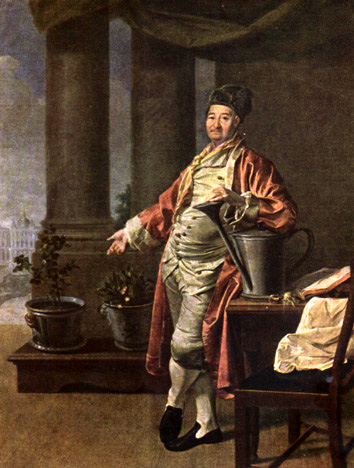| |
Dmitrii Grigorievich Levitskii, 1735-1822,
was born in Ukraina, the son of an Orthodox priest and a skillful engraver.
There is no information about his early schooling, which must have been related
to iconography and painting since later one of his duties in Kiev was to
inspect the canonical correctness of new icons painted by other artists. It was
here that Alexei Antropov met him when he arrived from Saint Petersburg to
decorate the Cathedral of Saint Andrew in Kiev (1747-1767) built by Bartolomeo
Rastrelli (1700-1771).When in 1756 Antropov was recalled to Moscow he took his
protégé with him. Soon Levitskii was taking lessons from
Antropov, lessons which continued later when both painters met again in Saint
Petersburg. Here Levitskii attended classes at the Academy of Arts and studied
under Louis-Jean Francois Lagrenee and Giuseppe Valeriani who exercised a
strong influence on him. A decade later Levitskii himself became a teacher of
portrait painting at the Academy. At this time painters did not depend solely
on their royal clients, as was often the case before, and the talented
Levitskii easily became between 1770 and 1790 the top painter of Russian court
and high society, which, not without reason considered him equal to the best
European masters. Levitski's early paintings are strongly influenced by Tocque.
It was during the seventeen eighties that Levitskii produced his best
paintings. Among them are portraits of the wilful Maecenas P. A. Demidov and A.
F. Kokorinov, of the well known educator and publisher N.I. Novikov and also of
the French philosopher Diderot who, at the invitation of Catherine II, spent
over a year in Saint Petersburg. After 1795 Levitskii developed a neo-classical
style. His portraits of Russian ladies are even finer. The riches of their
jewelry and dresses, the lustre of the silk and the velvet, the delicacy of the
veils and laces and the beauty of the hairdos made his portraits fashionable
among the already spoiled rich merchants and aristocrats. But Levitskii was
also a master of color, and he knew how to show the graciousness of a beautiful
woman's body and the caprices of her nature. The best are those of N. S.
Borshchova, E. N. Khovanska, E. N. Khrushchova, M. A. Diakova, and one of a
visiting Italian singer, Anna Davia. His series of portraits of the girls of
the Smolny Institute (the Imperial Institute for Daughters of the Nobility)
founded in 1764 by Catherine II is a charming collection. Levistkii painted
seven portraits of the girls. The portrait of Catherine Nelidov, the future
mistress of Emperor Paul I, was commissioned by Catherine II in 1773. Here is
one of his portraits of women.
Levitskii's fame began to decline when he started paying more attention to the
psychological characteristics of his clients and less to their vanity, pride
and pomposity. The nobility quickly neglected him when the equally talented but
more flattering and dainty Austrian portrait painter, D. B. Lampi arrived in
Saint Petersburg (1751-1830). It appears that once Lampi became well
established, Levitskii did not receive a single request to paint. While this
information appears to be exaggerated, it is true that the old Levitskii lived
long while the 19th century demanded something new. The end of Levitskii's life
must have been miserable; he became blind and died almost completely forgotten.
Here we have the portrait of Prokofy Akinfiyevich Demidov painted in 1773.
|
|


